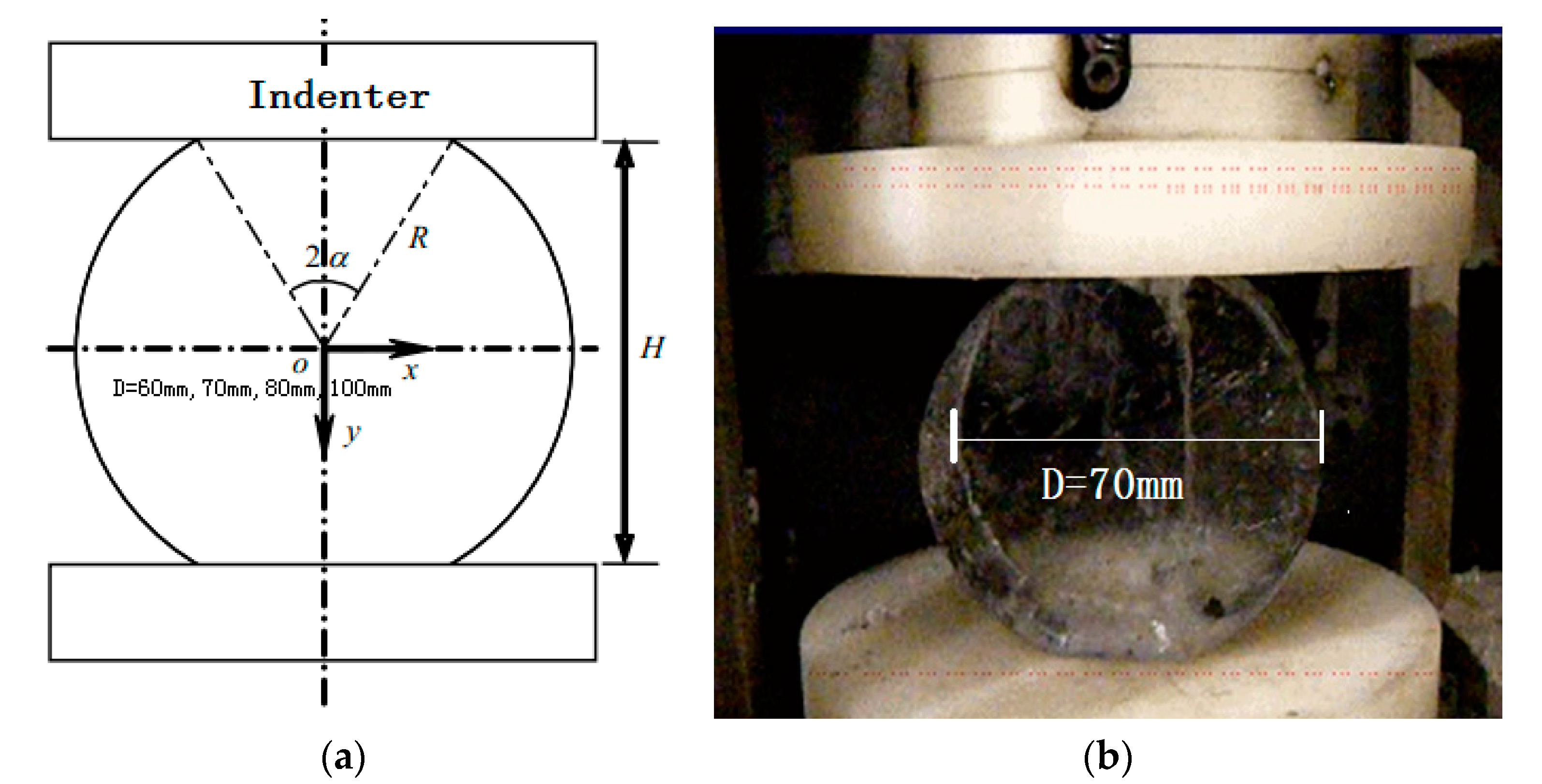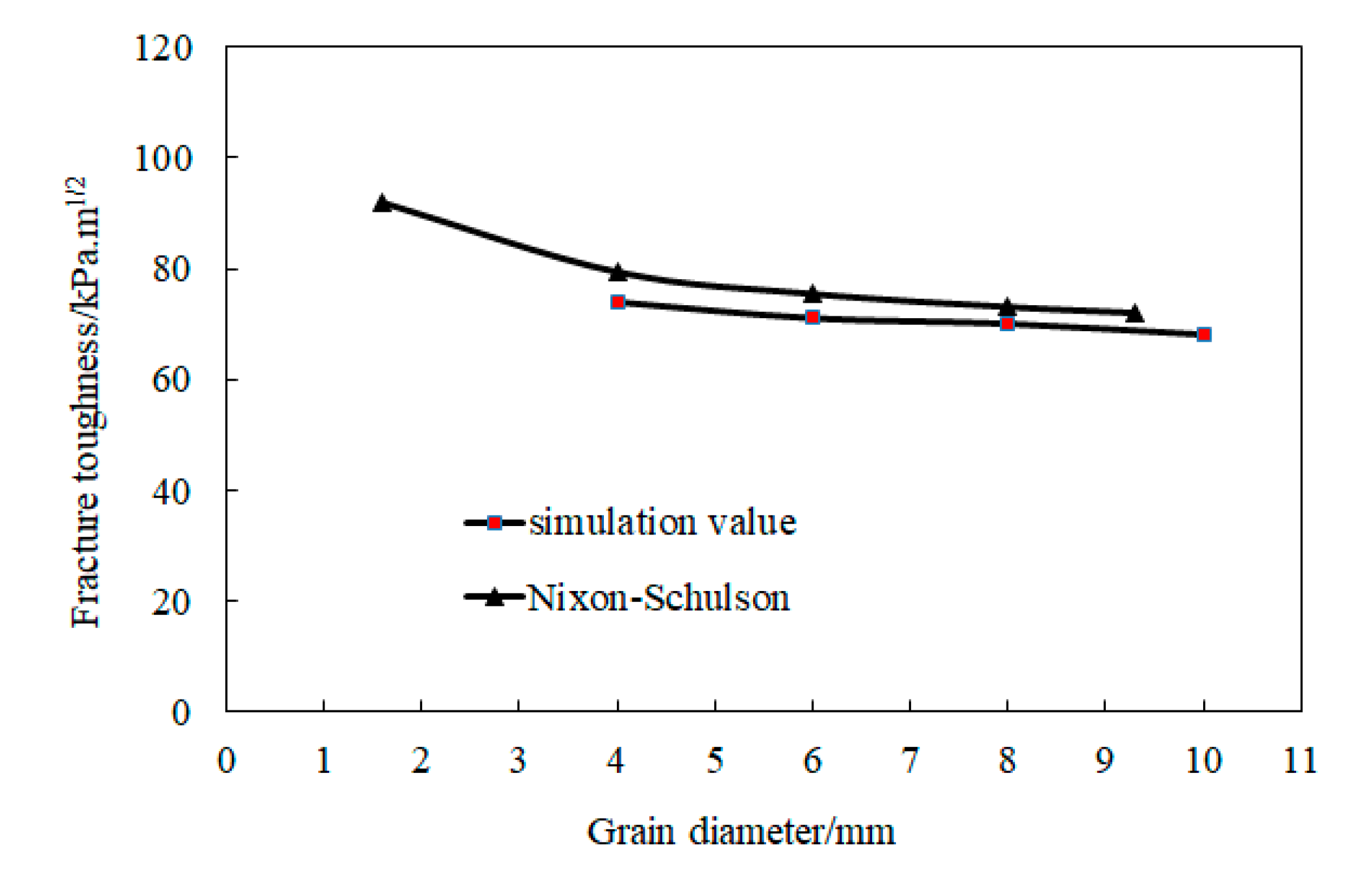Numerical Simulation of Ice Fractures Process of the Yellow River Based on Disk Specimen
Abstract
:1. Introduction
2. Ice Sampling Observation and Physical Test of the Yellow River
3. Numerical Simulation of River Ice
3.1. Crystal Structure Model of Yellow River Ice
3.2. Constitutive Relationship and Failure Criteria
3.3. Computational Parameters
4. Simulation Process of Disk Splitting
5. Simulation Results and Discussions
5.1. Simulation Results Analysis
5.2. Scale Effect of Fracture Toughness
5.3. Effect of Grain Size on Fracture Toughness
6. Conclusions
Author Contributions
Funding
Acknowledgments
Conflicts of Interest
References
- Pritchard, R.B.; Lough, C.E.; Currie, D.J.; Holme, H.L. Equilibrium reactions of n-butanethiol with some conjugated heterogenous compounds. Can. J. Chem. 1968, 46, 775–781. [Google Scholar] [CrossRef]
- Solomentsev, G.Y.; English, N.J.; Mooney, D.A. Hydrogen bond perturbation in hen egg white lysozyme by external electromagnetic fields: A nonequilibrium molecular dynamics study. J. Chem. Phys. 2010, 235102, 133. [Google Scholar] [CrossRef] [PubMed]
- Kendall, K. Complexities of compression failure. Proc. R. Soc. A Math. Phys. Eng. Sci. Lond. 1978, 361, 245–263. [Google Scholar]
- Zou, B.; Xiao, J.; Jordaan, I.J. Ice fracture and spalling in ice structure interaction. Cold Reg. Sci. Technol. 1996, 24, 213–220. [Google Scholar] [CrossRef]
- Evans, A.G.; Palmer, A.C.; Goodman, D.J.; Ashby, M.F.; Hutchinson, J.W.; Ponter, A.R.S.; Williams, G.J. Indentation spalling of edge loaded ice sheets. In Proceedings of the 7th IAHR Ice Symposium 1984, Hamburg, Germany, 17 July 2017; pp. 113–121. [Google Scholar]
- Xiao, J.; Jordaan, I. Modeling of fracture and production of discrete ice pieces. In Report for Canada Oil and Gas Land Administration; Lan Jordaan and Associates Inc.: St. John’s, NL, Canada, 1991. [Google Scholar]
- Xiao, J.; Jordaan, I.J. Application of damage mechanics to ice failure in compression. Cold Reg. Sci. Technol. 1996, 24, 305–322. [Google Scholar] [CrossRef]
- Han, L.; Li, F.; Yue, Q.J. Simulation of the whole failure process by fem during ice-conical structures interaction. China Offshore Platf. 2007, 22, 22–27. [Google Scholar]
- Cundall, P.A. A computer model for simulating progressive large-scale movements in block rock systems. In Proceedings of the International Symposium on Rock Mechanics, Nancy, France, 4–6 October 1971; Volume 1, pp. 8–11. [Google Scholar]
- Korlie, M.S. 3D simulation of cracks and fractures in a molecular solid under stress and compression. Comput. Math. Appl. 2007, 54, 638–650. [Google Scholar] [CrossRef]
- Jirasek, M.; Bazant, Z.P. Macroscopic fracture characteristics of random particle systems. J. Eng. Mech. 1995, 69, 201–228. [Google Scholar] [CrossRef]
- Jirasek, M.; Bazant, Z.P. Particle model for quasibrittle fracture and application to sea ice. J. Eng. Mech. 1995, 121, 1016–1025. [Google Scholar] [CrossRef] [Green Version]
- Ji, S.; Wang, A.; Li, B.; Liu, Y.; Li, H. Modified discrete element model for sea ice dynamics and its applications in the Bohai Sea. Acta Oceanol. Sin. 2015, 37, 54–67. [Google Scholar] [CrossRef]
- Ji, S.Y.; Sun, S.; Yan, Y. Discrete element modeling of rock materials with dilated polyhedral elements. Procedia Eng. 2015, 102, 1793–1802. [Google Scholar] [CrossRef] [Green Version]
- You, M.; Su, C. Split test of flattened rock disk and related theory. Chin. J. Rock Mech. Eng. 2004, 23, 170–174. [Google Scholar]
- Ministry of Water Conservancy of China. Specification for Rock Test of Water Resources and Hydropower Development: SL264-2001; China Water Power Press: Beijing, China, 2001; pp. 32–33.
- Wang, Z.Q.; Dai, F.; Jia, X.M. Reply to the Paper’ Split test of flattened rock disc and related theory. Chin. J. Rock Mech. Eng. 2004, 23, 175–178. [Google Scholar]
- You, M.Q.; Su, C.D. Experimental study on split test with flattened disk and tensile strength of rock. Chin. J. Rock Mech. Eng. 2004, 23, 3106–3112. [Google Scholar]
- Xu, G.; Chen, F.; Xiao, J.Q. Influence of load contact condition on rock tensile strength. Chin. J. Rock Mech. Eng. 2006, 25, 168–173. [Google Scholar]
- Gao, G.M.; Yu, D.; Li, S.X. Research on splitting performance of river ice of Yellow River in the freezing period. Yellow River 2018, 40, 28–30. [Google Scholar]
- Yu, D.; Juan, W.; Zan, X. The selection of microscopic parameters in building fracture microscopic model of river ice. Yellow River 2017, 10, 27–31. [Google Scholar]
- Arakawa, M.; Maeno, N. Mechanical strength of polycrystalline ice under uniaxial compression. Cold Reg. Sci. Technol. 1997, 26, 215–229. [Google Scholar] [CrossRef]
- Dempsey, J.P.; DeFranco, S.J.; Adamson, R.M.; Mulmule, S.V. Scale effects on the in-situ tensile strength and fracture of ice Part I: Large grained freshwater ice at Spray Lakes Reservoir, Alberta. Int. J. Fract. 1999, 95, 325–345. [Google Scholar] [CrossRef]
- Schulson, E.M.; Duval, P. Fracture Toughness of Ice. Creep and Fracture of Ice; Cambridge University Press: Cambridge, UK, 2009; pp. 190–211. [Google Scholar]
- Nixon, W.A.; Schulson, E.M. Fracture toughness of ice over a range of grain sizes. J. Offshore Mech. Arct. Eng. 1988, 110, 192–196. [Google Scholar] [CrossRef]








| Temperature (°C) | Strain Rate (s−1) | Elastic Modulus of Grain (GPa) | Strength of Grain (MPa) | Poisson’s Ratio of Grain | Elastic Modulus of Crystal Boundary (GPa) | Strength of Crystal Boundary (MPa) | Initial Defect Content (%) | Grain Size (mm) |
|---|---|---|---|---|---|---|---|---|
| −10 | 10−5–10−6 | 9 | 1 | 0.3 | 5 | 0.5 | 6 | 2–10 |
© 2020 by the authors. Licensee MDPI, Basel, Switzerland. This article is an open access article distributed under the terms and conditions of the Creative Commons Attribution (CC BY) license (http://creativecommons.org/licenses/by/4.0/).
Share and Cite
Wang, J.; Zhou, J.; Deng, Y.; Vadim, G.; Zhang, P. Numerical Simulation of Ice Fractures Process of the Yellow River Based on Disk Specimen. Crystals 2020, 10, 598. https://doi.org/10.3390/cryst10070598
Wang J, Zhou J, Deng Y, Vadim G, Zhang P. Numerical Simulation of Ice Fractures Process of the Yellow River Based on Disk Specimen. Crystals. 2020; 10(7):598. https://doi.org/10.3390/cryst10070598
Chicago/Turabian StyleWang, Juan, Jiao Zhou, Yu Deng, Goncharov Vadim, and Peng Zhang. 2020. "Numerical Simulation of Ice Fractures Process of the Yellow River Based on Disk Specimen" Crystals 10, no. 7: 598. https://doi.org/10.3390/cryst10070598





